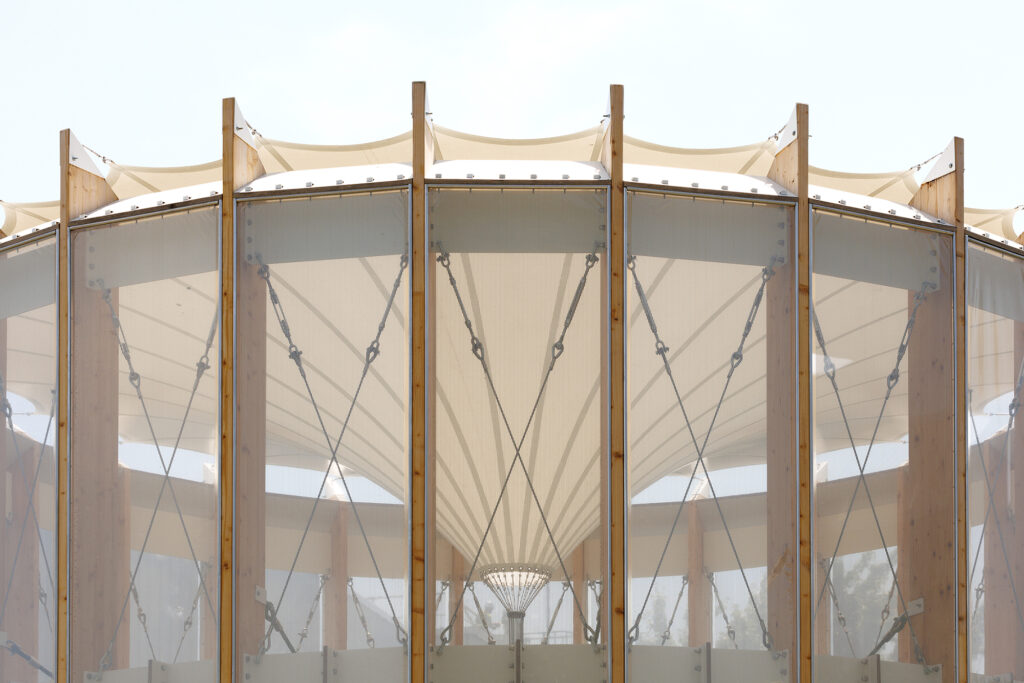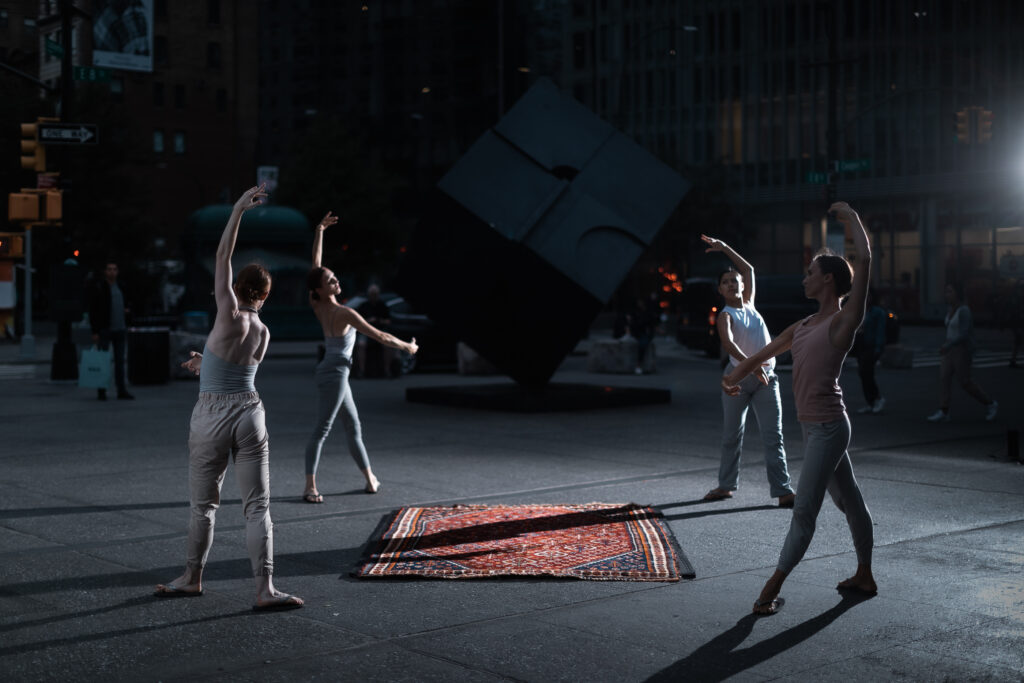
Beyond Better Tools:
Reframing biotechnology at Asilomar with Anton Jackson-Smith and Gabrielle Lamb
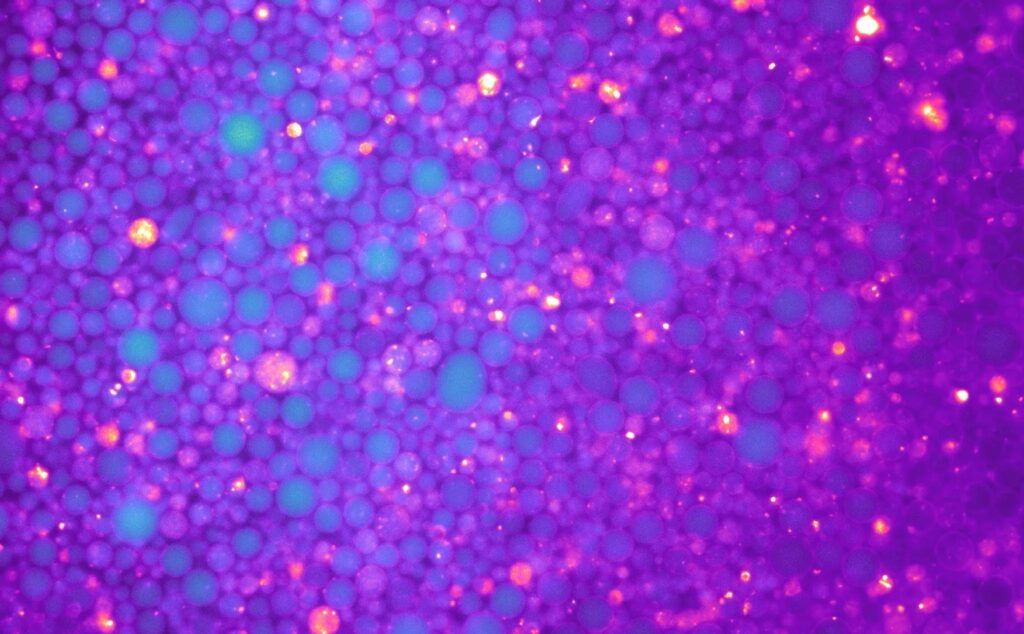
"Synthetic biology, molecular biology—there’s a lot of stories happening there, a lot of drama. And it’s all about movement, because movement is life at every scale."
DECODING MEANING
For Anton, growing up in New Zealand, the internet was his first canvas for creativity—until he learned about synthetic biology and became captivated by the idea of programming life. His journey took him from coding software to molecular biotechnology, and eventually to Stanford, where he encountered the hard truth: cells don’t come with easy instructions. ‘You can’t just program them’, he says, ‘but you can see the symmetry with where biology could go.’ That vision now fuels his work building synthetic cells—creative tools that bring us closer to life’s complexity.
Gabrielle’s path in dance, rather than DNA, might appear to pull in the opposite direction, yet, as it has been revealed in this quantum exchange, even in perceived difference, there is an irresistible gravity as ancient as the laws of nature. The deeper parallel is undeniable: the dance of life unfolds, whether on stage or inside a cell.
A classically trained ballet dancer turned contemporary choreographer, Gabrielle discovered the world of gene editing during the pandemic, through an open call from the MIT Museum. Her CRISPR-inspired choreography drew on the action verbs of molecular biology—cut, copy, paste—and soon led her to Asilomar, where she performed with her company Pigeonwing Dance. But what stayed with her wasn’t just the performance. It was the question: What can dance do in the world, beyond what we expect of it? As Gabrielle puts it, ‘Synthetic biology, molecular biology—there’s a lot of stories happening there, a lot of drama. And it’s all about movement, because movement is life at every scale.’
Both were present for the commemoration of the 50th anniversary of the world-famous 1975 gathering in Californian Asilomar, a landmark conference that established safety guidelines for recombinant DNA research, and whose legacy continues to shape not only scientific innovation but the principles that guide it. It is within this historic and forward-looking context that their uncanny conversation unfolds, bringing together creative minds to explore the choreography of biology—and how both science and art are wrestling with the same questions: What can we build? What should we build? And how do we make meaning from life in motion?
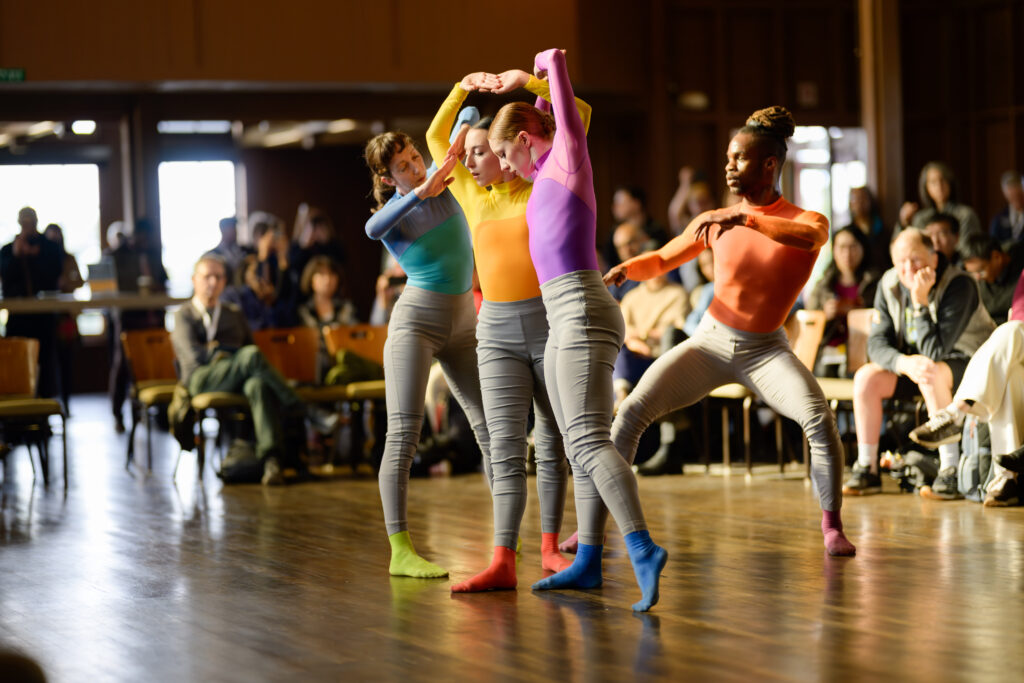
"In a way, synthetic cells are studied as a way to test our understanding of life itself: either to show that we know enough to start building it from the bottom up, or to reveal the gaps in our knowledge. If we do manage to create a replicating synthetic cell, it would raise entirely new questions about what qualifies as living."
COMPOSING DYNAMIC POSSIBILITIES
Natsai Chieza: Whether through engineered cells or dance, your work blends design, responsiveness, and the emergent qualities of organisms with the infrastructures that give them form.
Anton, what is your definition of a synthetic cell, and what assumptions does it challenge about what a living system can be?
Anton Jackson-Smith: Great question. There are different kinds of synthetic cells, but when I use the term, I’m referring to what we consider a ‘bottom-up’ synthetic cell.
If you imagine the kind of bioengineering that operates at the cellular level today, one typically takes a cell and modifies it in some way. You might add a plasmid [t. - 1] to make it produce insulin, for instance, or make changes to the genome to get it to do something new. In either case, you’re editing a complete living system that already exists in nature. That approach has been incredibly successful for many purposes, but it’s still very complex, because we’re modifying a system we don’t fully understand. The bacterium E. coli—the most commonly studied and engineered organism in synthetic biology—has around 3,500 genes, and about a third of them still have unknown functions. On top of that, the cell usually has its own agenda. You might say, ‘I want you to make insulin,’ and the cell’s more like, ‘I just want to grow as fast as I can.’
And this is the key difference: with a synthetic cell, instead of modifying a cell that already exists, we take the individual components of a cell—the proteins it needs, the small molecules, the DNA that encodes whatever it’s going to do—and we use purified versions of those. We then mix them together and encapsulate them, for now, in a very simple lipid membrane, [t. - 2] Â which makes a cell. Unlike with genetically engineered living systems, we know exactly what all the components are, why we’ve put them there and what they’re supposed to do. From an engineering perspective, it starts to resemble a more predictable system. You can anticipate how it’s going to behave, and if you want to change something or try a different function, you have a clearer idea of what to adjust and what’s likely to work. It’s no longer just an open-ended research exercise.
What the synthetic cell immediately does is provoke the question of ‘what is life,’ which people have been trying to answer forever. If life involves replication—at the moment, these synthetic cells can’t divide, so they can’t make more of themselves—then it’s pretty clear that the synthetic cell is not alive. In a way, synthetic cells are studied as a way to test our understanding of life itself: either to show that we know enough to start building it from the bottom up, or to reveal the gaps in our knowledge. If we do manage to create a replicating synthetic cell, it would raise entirely new questions about what qualifies as living.
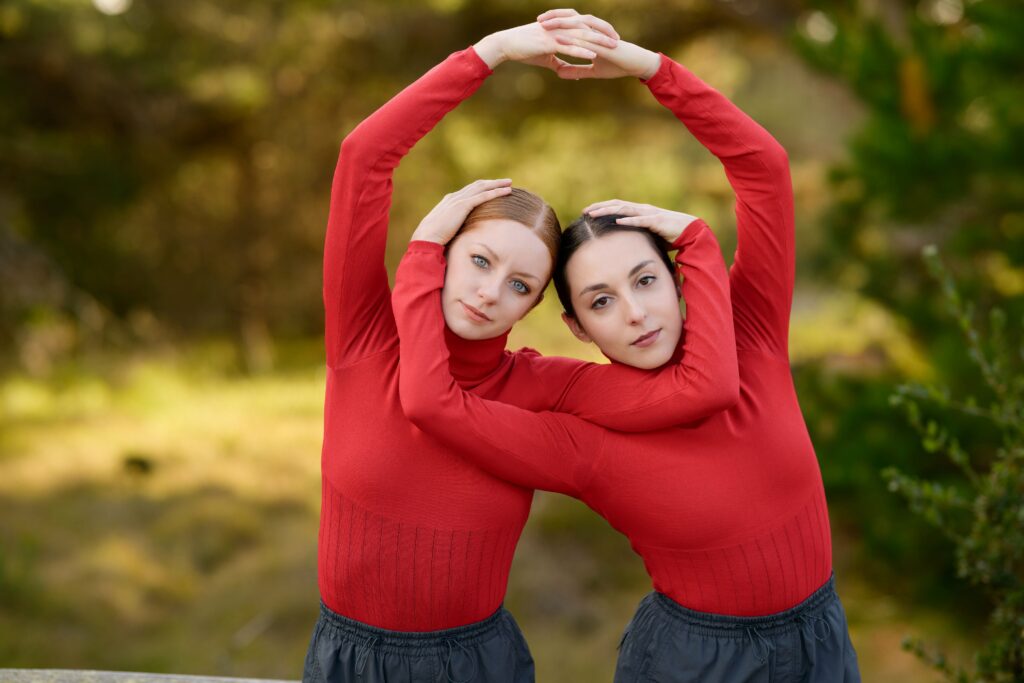
Natsai Chieza: Gabrielle, I really liked what you said about movement. I think it highlights the importance of recognising that what matters most is the flux through the system. It’s very easy to think of a synthetic cell in terms of nouns, not verbs—to focus on the components’ names. But what actually matters is how those pieces interact and behave together in a dynamic environment.
Gabrielle Lamb: In the research preceding the making of ‘The Choreography of CRISPR’, my biggest takeaway was that DNA is not simply a code. There’s still much we don’t understand about how it functions. The way DNA moves—the wrapping, folding, which parts are accessible at different times, and their proximity to one another, all tangled up—plays as much a role as the actual genetic code itself.
Anton Jackson-Smith: Spatial organisation alone matters a great deal. Your DNA has to fit inside the cell, but its position relative to other elements is also important. I hadn’t appreciated, before the Asilomar conference, just how much synergy there is between dance and biology.
Gabrielle Lamb: It’s all about space. When I was a young dancer, I found it so dull when the people in charge would harp on, ‘you should be two feet to the left’ or ‘you need to move upstage five feet’. Such a boring kind of correction to get. But as a person painting the image in space, it is so important where things happen.
Natsai Chieza: How do you think about composition, then? How do you translate ideas into form—into movement?
Gabrielle Lamb: For me, composition begins with small pieces rather than a big blueprint; from the ground up, not from 10,000 feet up. First, I start with movements. Sometimes I work alone in the studio with a camera to create very basic building blocks—small movements that don’t have any particular meaning, except that I find them interesting. To me, interesting means they are somewhat unpredictable, yet in retrospect seem inevitable.
The next level up is how I combine bodies. What happens when this movement involves two bodies, not just one? How do gravitational forces flow through multiple connected bodies, and how do multiple bodies relate to one another in space?
Finally, the next level is time. How do all these elements combine into a structure, a flow that makes sense over time and forms an arc for the viewer?
Anton Jackson-Smith: What you said is fascinating, because that’s exactly what we’re doing too: engineering an entire human cell all at once.
From my engineering perspective, when we build synthetic cells, we start with small modules. At the moment, that might be as simple as a single gene or a single protein that performs one function, or increasingly, a couple of components working together. Then we compose those modules to create more complex systems inside the synthetic cell.
Our first project with the company was to build three prototype cells to demonstrate potential and work out some engineering fundamentals: a detector cell, which senses a small molecule signal; an emitter cell, which produces a small molecule signal; and a responder cell, which combines those two functions—it detects a signal and then emits a new one. Interestingly, it could do this in concert with living cells, specifically E. coli. So, the synthetic cell detects a signal and emits a molecule that causes the E. coli to respond in some way. We’ve created an engineered system that can work alongside living cells, giving us new ways to investigate or even ‘talk to’ them. The composition happens on both levels: building modules within the synthetic cell and integrating synthetic cells with parts of the natural world. One key component we call ‘control’, which sounds a bit intimidating, but it’s really about how we manage what the synthetic cell does in space and time. How do we turn functions on and off? How do we make sure the cell only responds when we want it to?
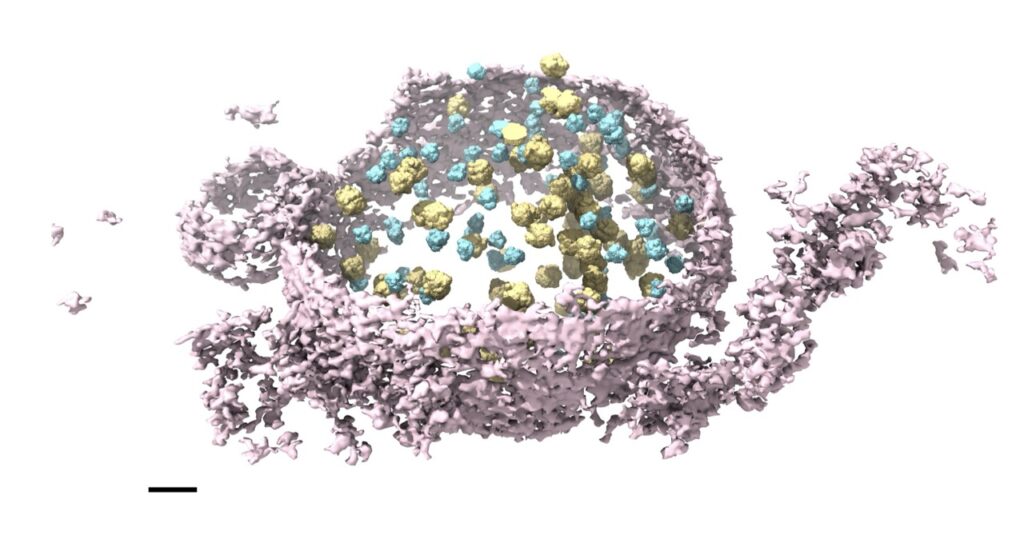
"At the core of what we do is the composition of proteins, DNA, and lipids that make up a cell. But there’s a broader layer to our work too, which is about how we integrate existing pieces together in new ways that allow them to function collectively. We’re doing that both inside synthetic cells and across different systems—connecting cells, and linking biological technologies with digital ones."
FLOW
Natsai Chieza: If working with life means embracing uncertainty and complexity, then both of you are, in your own ways, engaged in creating something readable through composition or performance that can hold form within that uncertainty.
Gabrielle, you’ve already used the word ‘improvisation’. Could you talk a bit more about that? How do you navigate the space between control and surrender in your work?
Gabrielle Lamb: Every project begins with improvisation, but each one uses it differently. When I’m working with dancers, I need to have something prepared—a prompt or instruction to start with. It might be, ‘What if you do this movement while orbiting?’ or ‘What if you’re touching her elbow?’ I try to keep it minimal, exercising as little control as possible to see what emerges. If it’s too vague, then I’ll add more constraints or detail, but still aim to avoid over-directing.
As the process progresses, I tend to take more control. It depends on who I’m working with, but some performances still include moments of improvisation. For example, in a project we do on a Persian carpet [t. - 3] in public spaces around New York City, the choreography might be entirely set, but I’ll play a piece of music the dancers haven’t heard before. They have to respond in real time, holding the structure in mind, but adapting it based on what they hear and anticipate in the moment.
At Asilomar, The CRISPR program that we performed was quite set. However, we did some other dance activations about mirrored life, pathogens and biological weapons, which were structured improvisations. The dancers were operating with a series of rules, but we tried them out in different spaces: in the chapel, outdoors, and at the dining hall.
And then there was the performative ritual at the beach, where participants were invited to bury whatever needed parting with. That was quite an improvisation—I’d never done anything like it before, especially guiding a group of people who weren’t dancers. If you ask dancers to stand in a circle, they immediately form a beautiful, symmetrical shape. So at Asilomar, two of the dancers had the job of arranging the scientists in a circle, and it seemed for a moment like it was never going to become anything like a circle.
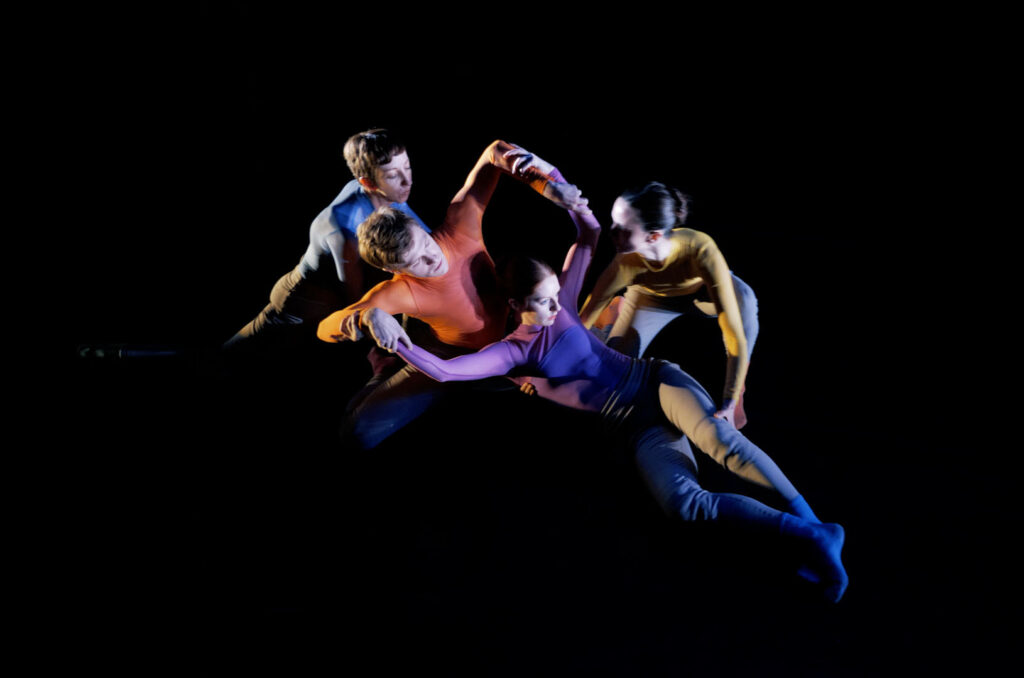
Natsai Chieza: Anton, your technology platform is designed as a distributed system, which allows for a certain flexibility and improvisation. How are you thinking about managing the complexity that comes with that kind of openness, while still building something durable? And in the context of distributed biotechnology, how do you ensure the model can adapt to local cultures, geographies and politics, yet still stay aligned with your core values?
Anton Jackson-Smith: At the core of what we do is the composition of proteins, DNA, and lipids that make up a cell. But there’s a broader layer to our work too, which is about how we integrate existing pieces together in new ways that allow them to function collectively. We’re doing that both inside synthetic cells and across different systems—connecting cells, and linking biological technologies with digital ones.
For now, the goal is to begin reconstructing some of the complexity we know exists in life itself. Take homeostasis, for example—the ability of a cell to maintain internal balance in response to its environment. That kind of regulation is what makes living cells so robust. They can sustain their chemical composition, break down unfamiliar compounds, or adjust their behaviour to stay in sync with changing conditions. The challenge is how to recreate that from the bottom up, in a way we can fully understand and integrate with other parts.
But we’re also thinking at the level of people: how do we bring the right individuals together so they can collaborate effectively? At the moment, biological collaboration tends to be quite limited—you might be working with someone in your department, or perhaps with another lab across the country. In contrast, the computing world operates at a completely different scale. You have hundreds or even thousands of people working dynamically on shared projects, from building websites to developing Linux, and somehow it all holds together. What might the future of biotechnology look like if we could collaborate at that scale?
There’s this implicit argument that if I put everything in a cell, and I had a reason for doing that, it should be understandable how those pieces work together. We’ve seen in other aspects of engineering that if you can do this, then things can work reliably, you can achieve a level of abstraction, where someone makes a module, and the other person can put it in their cell without having to understand every nuance of what it’s doing or how it’s working. And that’s what lets you get to greater levels of complexity, where each person manages their own parts. For example, I want the cell to solve a problem such as detecting a crop pathogen, but I don’t have to think about how the metabolism is exactly making the energy. My long-term aim is to build something durable and resilient, with all the fundamental capabilities needed to make a synthetic cell useful, so that the users wouldn’t need to grapple with all the internal complexity.
That’s what makes this such a powerful technology—not just for solving problems, but as a creative tool. What excites me most is the idea that someone might use it to address an issue I’ve never encountered, or approach a challenge in a way I wouldn’t have imagined. That kind of unexpected possibility is both beautiful and inspiring.
Natsai Chieza: I remember when I visited you in your lab, you mentioned the potential for animal testing to happen using synthetic cells. For brands that’s huge, where the claim around the product can be made transparent because of the backend: ‘This is how we do it using these tools.’ How would you frame your vision for a brand that wants to understand why synthetic cells are relevant to their complex supply chains?
Anton Jackson-Smith: The way you just framed it is actually what I was getting at. If I have a cell that can behave in the same way a human or an animal would, then that’s a powerful tool for changing that problematic part of the supply chain. The other thing we’re looking into in the near term on the sensing and detection side is in biomanufacturing and fermentation. If you’re growing a big reactor full of cells to make anything—from dye to a therapeutic—by being able to have synthetic cells in that mix reading out signals and potentially providing them as well, can you make that process more efficient and effective?
I have this rough hypothesis that the real challenge in distributed biotech manufacturing is not necessarily the making—‘here’s the cell that makes the insulin’—but the quality assurance and downstream processing. It’s one thing to say, ‘I can grow this reactor of cells in my town,’ and quite another to prove conclusively that I made what I intended, that it’s exactly what I thought it was, and that it’s safe for people. Synthetic cells could potentially provide that angle. If you have a readout that can say, ‘Yes, you did not make any side products. It is sufficiently pure that it would be a very powerful enabling tool for distributed biomanufacturing, reducing the infrastructure needed around actually making the specific thing you’re trying to produce.
Natsai Chieza: What I’m hearing from you is that it’s almost like you’re describing a living bioreactor.
Anton Jackson-Smith: In a sense, that’s what every cell is, right? Except it’s a bioreactor we more fully understand. The other kind of power synthetic cell has is a new tool for working with nature. Since the synthetic cell is like engineering on the inside and biology on the outside, you can enter a completely novel discourse with the living system itself.

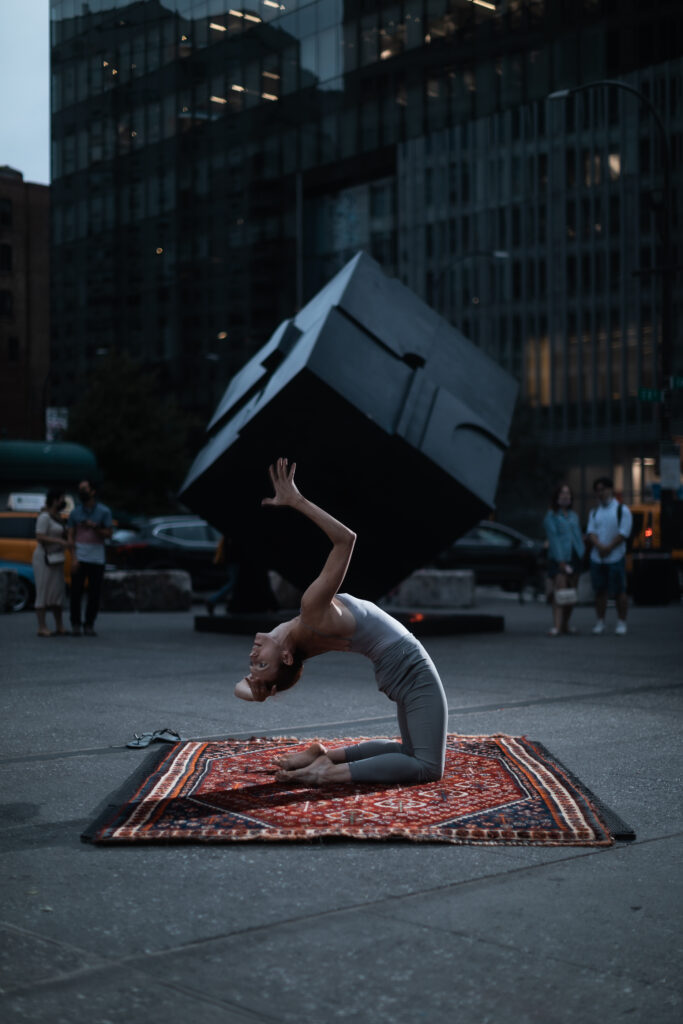
"At Asilomar, I spoke with a researcher from Rice who watched an earlier demonstration, in which I read words like ‘guiding’ and ‘folding’, while the dancers performed those ideas physically. She told me that in the lab, they often think of those processes in very mechanical terms: you follow the instructions, you do the steps. But when she saw the way one dancer guided another, she noticed tenderness, care. It made her think differently about the processes she works with—the ones she can’t actually see. And it made her wonder about the quality of those interactions at the molecular level."
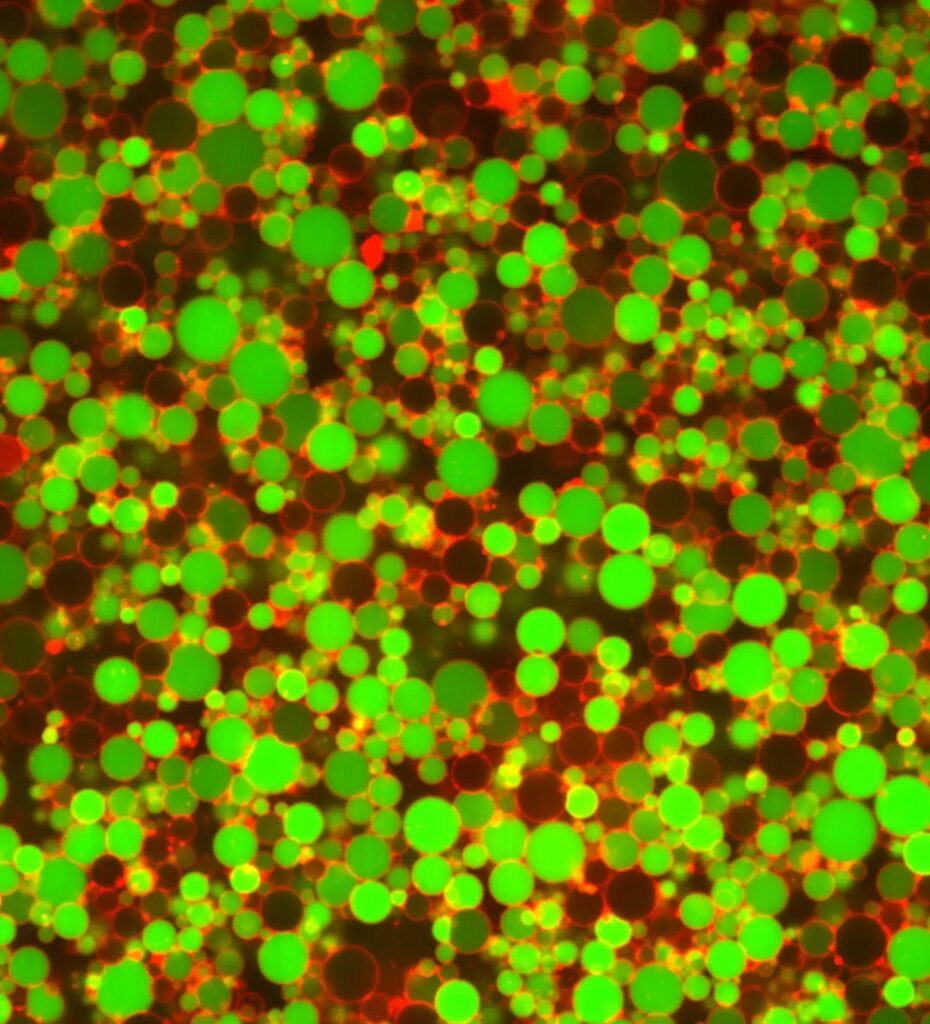
ON MATTER AND POWER
Natsai Chieza: There seems to be a cultural shift happening—a reframing of who gets to shape knowledge, who has access to the tools of science and creativity, and how those tools are used. Both of your practices seem to challenge those boundaries in different ways.
Gabrielle, your work suggests that embodiment, through dance and performance, can open up new ways of engaging with scientific ideas. Do you see that as a form of access, helping people connect with complex systems like biology through movement and feeling?
Gabrielle Lamb: One of the biggest questions I was asking myself while creating the CRISPR piece—the one I showed at Asilomar and later at the MIT Museum—was, who is this for? It’s easy to assume this kind of work is just science communication, something like an illustration or a medical animation. But that’s not quite what I was making. Others have done that more directly. For example, Paul Berg was involved in a project at Stanford in the 1970s called Protein Synthesis, [t. - 4] where students acted out molecular processes on a football field. It was quite literal and educational. That’s not my background, and I didn’t feel comfortable trying to recreate something similar. So I kept asking myself, what am I actually doing here?
As I’ve shown the work in different contexts and spoken to different audiences, I’ve started to understand it in new ways. At the museum, for instance, people are surrounded by dense scientific information. The performance can offer something else—a kind of mental pause, an invitation to engage through the body, not just the intellect.
At Asilomar, I spoke with a researcher from Rice who watched an earlier demonstration, in which I read words like ‘guiding’ and ‘folding’, while the dancers performed those ideas physically. She told me that in the lab, they often think of those processes in very mechanical terms: you follow the instructions, you do the steps. But when she saw the way one dancer guided another, she noticed tenderness, care. It made her think differently about the processes she works with—the ones she can’t actually see. And it made her wonder about the quality of those interactions at the molecular level.
I do think there’s something implicit in the fact that the dance work is made of people. These are human bodies, often close to the ground, physically vulnerable. Sometimes, I think of the piece as an invitation to proceed with humility. And maybe that comes across, because it’s embodied and not abstract—it’s made of us.
Natsai Chieza: I think about that a lot, especially in the context of the bioeconomy conversations at Asilomar. Many of them were framed around work done by the World Economic Forum’s Global Future Council on Synthetic Biology, which I and other delegates at Asilomar were a part of. A big motivation of that work was trying to define the terms of engagement—to ask, what are the values we’re putting forward as we advance these technologies? We had a set of core values that were being repeated on every stage: sustainability, solidarity, inclusion, for example. Helpful to signal intent yet lacking in meaning i.e.how they manifest in practice. That’s where I think artistic practice is essential. With intention, it’s intrinsic to the process of understanding and shaping what we’re making. It helps us frame the questions more clearly and imagine different futures with greater emotional and cultural depth.
Anton Jackson-Smith: As a scientist, my first instinct was to try to understand the CRISPR dance piece intellectually. I thought, ‘I know how this biological process works, so can I identify the parts in the movement?’ But then I realised I was making a mistake. What I needed to do was let go of that and instead follow the emotional current of the piece—interpreting it through feeling rather than analysis—and try to grasp the truth you were communicating in that way. So I’m curious, Gabrielle, how do you see people respond to it?
Gabrielle Lamb: The people watching usually know far more about how these things work than I do. What I have to offer is more about impressions and feelings. My hope is that they gain some kind of emotional appreciation for CRISPR, though it’s hard to say exactly what that looks like. Perhaps it’s about being able to stand at a different vantage point and see what they do from a perspective they don’t usually get.
For example, when we danced at the MIT Museum, there were moments when the dancers formed hexagonal shapes that looked like illustrations of molecules. I noticed some people around me saying, ‘Yes, I see it now.’ So in some parts, I was able to be more literal, and I think that definitely helped steer more direct engagement. It’s interesting, isn’t it? Balancing that literal and more abstract impression.
Anton Jackson-Smith: I think the notion of perspective is really interesting, because it’s easy to focus on the details or the way you tend to be taught stuff in biology, which is ‘here’s a textbook full of cartoons’ versus the actual dynamism, which is hard to appreciate in a flat, textbook form.
Gabrielle Lamb: Right, and the unpredictable, messy messiness of it in a way. I often felt, when trying to learn about this stuff, that I really wanted to get my hands on something. It was mostly reading and listening, but I craved a three-dimensional experience. I didn’t really have that until I created my dance piece about it. Throughout the process, I kept thinking, I wish I could somehow do it, not just understand it intellectually.
"But beyond technology, culture is equally important. If you want technology to be used for good, you have to build a culture around it that is positive, caring, and thoughtful. [...] You want diverse perspectives in the room to spot challenges early and understand how the technology affects different people."
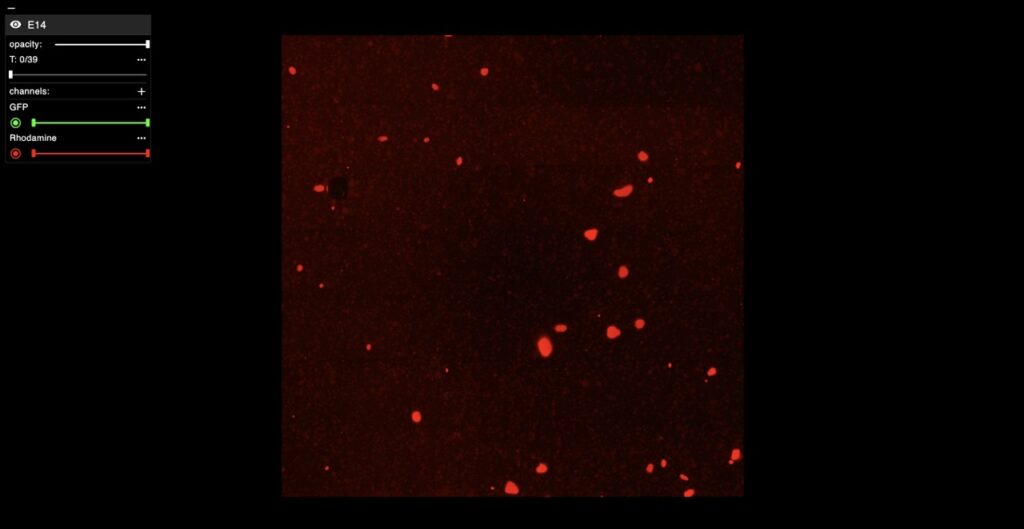
Natsai Chieza: Anton, how are you thinking about access at b.next—not just in terms of who uses scientific tools, but how knowledge is shared and interpreted?
Anton Jackson-Smith: I think there are different timescales and priorities to consider, but long-term access is critical, because there are so many problems that could be solved and improvements that could be made in the world—if more people were involved. No top-down approach comes close to the potential of empowering individuals or communities to tackle what matters most to them. That’s true across history, including in art, and it’s really powerful in the near term too.
Right now, we’re prototyping what we believe is a fairly unique open-core business model for biotech. We’re building an open-source package called Nucleus, which includes a collection of digital tools as well as instruction manuals—protocols and documentation for working with synthetic cells. It’s not just reading a scientific paper and trying to interpret the methods; it’s an actual set of resources and printable protocols you can use to get started, even if you’re new to the field.
Alongside that, we provide the biology itself—synthetic cells, DNA plasmids, purified proteins—basically, the modules you need. Accessing this DNA can be a huge barrier, so providing these components together is a big deal. For example, if you’re a student starting your PhD with an exciting question—say, figuring out how to get a synthetic cell to produce a protein that could help treat heart disease—the first hurdle is learning to make a synthetic cell. That alone can take one to two years.Our hope is that by providing shared tools and information—the best protocols, tested components that are designed to work together in the synthetic cell context—people can skip that long setup and get straight to their questions. This shared platform means that rather than everyone building their own bespoke system, which often doesn’t integrate well with others’ work, people can build on common tooling and components that just work together. This makes it easier to layer on complexity over time.
But beyond technology, culture is equally important. If you want technology to be used for good, you have to build a culture around it that is positive, caring, and thoughtful. There’s huge potential for good in medicine, agriculture, climate resilience, and more—but also risks of harm. Rules and technology help, but the culture you cultivate makes a big difference. You want diverse perspectives in the room to spot challenges early and understand how the technology affects different people.
Right now, we’re about to hold our first hands-on workshop to teach people how to build the core transcription-translation system we use in synthetic cells. Normally, this takes about 18 months of experience, but we’re trying to teach it in one week. It’s a bit of an experiment, but if it works, more people can get to the starting line faster and join the community. Since synthetic biology is still relatively new, the community is still small enough that we have a real chance to shape how it grows and functions before it expands massively. That’s something I think about a lot—what kind of culture do we want to build, and how do we involve more people in co-creating that future?
"There’s something about synthetic biology that feels different to me. I consider myself an artist in some ways: the act of engineering combines intellectual work with creativity and craftsmanship. It’s profoundly human and connected to nature, core to our existence in the world. What’s unique here is that I can engage with this creatively—I can actually compose with it. That intersection of creativity and biology feels uniquely powerful compared to just studying or observing nature passively. So maybe you’re right—there is something intrinsic and special about this field."
Natsai Chieza: When I entered the field around 2011, there was a striking diversity, with many people coming through biotech startups, some of which became full-grown companies. Then came the boom and bust phase, and some of that early energy seemed to fade. Maybe that’s just part of the life cycle of a growing field. What’s exciting now is the steady influx of a new generation bringing fresh perspectives and new ideas about how this technology can evolve to meet the needs and conditions of the world today.
How do you see this generational shift shaping the field—creatively, culturally or structurally?
Anton Jackson-Smith: I do think there’s definitely a hype cycle element to it, and I have mixed feelings about that. It’s a bit sad because there was so much vision and excitement early on, but then people became disillusioned when synthetic biology didn’t quite reach those expectations yet. At the same time, if you look at other technologies like computers, they went through similar phases—the dotcom boom, followed by a trough of disillusionment. Right now, we’re seeing something similar with social media. Even when the hype dies down, there are always people who deeply care and continue working quietly, and I think that’s been true for synthetic biology as well. I hope it will come back stronger.
Putting on my business hat, the economics of synthetic biology is another big factor. The ability to actually make synthetic cells is still largely limited to well-funded research universities because the tools are expensive. One of the hopes is that by open-sourcing some of these tools and parts, we can help bring costs down. I also think about the trajectory of cell phones as an analogy. The first cell phones were insanely expensive, worked in only a few cities, and were mainly for specialised users like stock traders. But now, farmers in remote countries can check market prices on their phones, and entire populations do their banking via cell phones. Some countries even leapfrogged traditional infrastructure by moving directly to 5G networks instead of landlines. That kind of technological learning curve drastically improves access over time. Synthetic biology is expensive and complicated right now, but as we make it more efficient and cheaper—and as the technology itself becomes more powerful—I’m optimistic about its future.
Gabrielle Lamb: I was speaking with Jane Calvert, [t. - 5] and she mentioned how many different kinds of people are drawn to synthetic biology—social scientists, artists, and others. Do you find that to be true more so than in other scientific or technical fields you’re familiar with? And as the field evolves, do you think it’s becoming less diverse in that way, or is it maintaining that broad range of perspectives?
Anton Jackson-Smith: I still think there could be more diversity. My perspective might be a bit biased, since I was Drew Endy’s [t. - 6] grad student and have been part of that intellectual community for a while—a community where genuine care for engagement and bringing in multiple perspectives was very much present. But there are other areas within synthetic biology, and especially in closely related scientific disciplines, where that diversity is lacking. It really comes down to the culture of the field you’re in.
Gabrielle Lamb: Do you think it’s that way simply because the people at the forefront made diversity a priority, or is there something inherent in the field itself that encourages it?
Anton Jackson-Smith: I haven’t reflected on this too deeply, but I do think that early synthetic biology was mostly driven by technologists. Yet, even then, people like Christina Agapakis were there thinking about art, and some of those early pioneers were intrigued by creative perspectives. That mindset was passed down to the community, so when generations like mine come through places like the IGEM competition, [t. - 7] they show up knowing that there are people thinking about safety, ethics, and also art—approaching the technology not just from economic or scientific angles, but from purely creative ones. That’s become an accepted part of the culture, and I think that’s really powerful.
There’s something about synthetic biology that feels different to me. I consider myself an artist in some ways: the act of engineering combines intellectual work with creativity and craftsmanship. It’s profoundly human and connected to nature, core to our existence in the world. What’s unique here is that I can engage with this creatively—I can actually compose with it. That intersection of creativity and biology feels uniquely powerful compared to just studying or observing nature passively. So maybe you’re right—there is something intrinsic and special about this field.
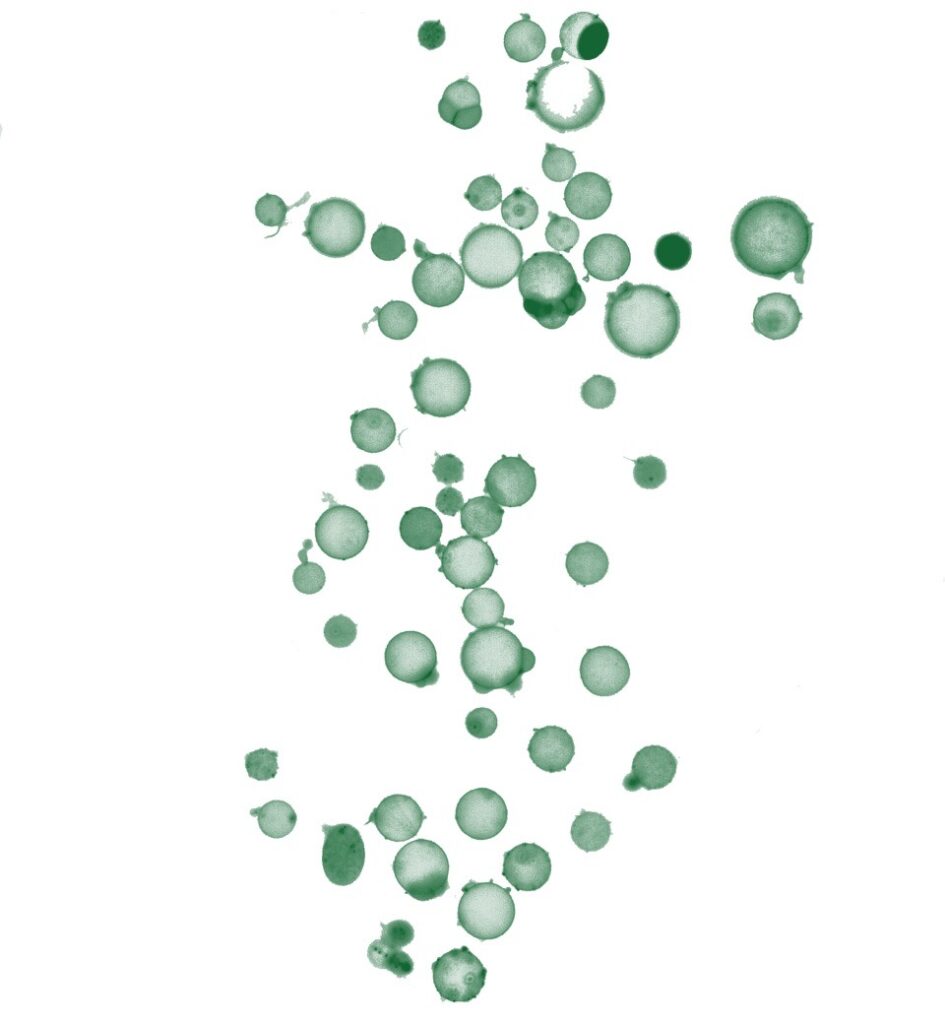
REFRAMING FUTURES
Natsai Chieza: Synthetic biology and AI are continuing to evolve and offering new possibilities, but also new risks. If we step back and look at technology more holistically, what do these developments reveal about who we are becoming? And in response, what do you think we need to reimagine?
Anton Jackson-Smith: I think, most immediately, you can absolutely see how it could become a powerful tool both for understanding biology and, potentially, for designing new biological systems. For example, a lot of researchers are using AI to design or optimise proteins and enzymes with new functions. People often ask if that’s how we build our synthetic cells—we don’t, at least not yet. But you can imagine a case where you need a synthetic cell to do something specific, and you can’t find the right part in nature. In that case, AI could be incredibly helpful in designing the missing piece.
When it comes to safety, AI does introduce new considerations, depending on how it’s being used. There are also a lot of people working hard to understand how AI arrives at its outputs—trying to make those processes more transparent. But even so, it might generate things we didn’t predict.
In the near term, I think synthetic cells could actually provide a safer testing environment for things created by AI. Right now, our synthetic cells are quite simple and, crucially, they can’t replicate. That’s a disadvantage if you’re aiming to build the world’s most complex cell. But if your goal is to deploy a biosensor in a field to detect a crop pathogen, a non-dividing cell completely changes how you approach safety. Similarly, if you’re designing new proteins and want to see if they behave as expected, using synthetic cells to produce them might allow for quicker, safer, and more controlled testing. They can’t ‘escape’, because they’re not part of a self-replicating system.
"There’s a lot of focus these days, including AI, on information: on bits and signals, on computation as the defining force in the world. Whether it's neurons firing or bits flipping in a chip, there’s this idea that information alone is what matters most. But I think there’s also a group of people, and I’d include myself in that, who care deeply about atoms, about the physical, material world. For me, bioengineering and synthetic biology are a way to bridge those two worlds—the digital and the material. That’s a powerful thing, not only practically but also as a way of thinking."
On a broader level, there’s something I really value about the kind of biotechnology we’re working on. There’s a lot of focus these days, including AI, on information: on bits and signals, on computation as the defining force in the world. Whether it’s neurons firing or bits flipping in a chip, there’s this idea that information alone is what matters most. But I think there’s also a group of people, and I’d include myself in that, who care deeply about atoms, about the physical, material world. For me, bioengineering and synthetic biology are a way to bridge those two worlds—the digital and the material. That’s a powerful thing, not only practically but also as a way of thinking.
Gabrielle Lamb: I use AI for things around my actual work, but it’s no help at all when it comes to working in the body, because it doesn’t have a body. I’ve even asked it for help composing a dance piece, and I found it completely useless. That said, it is helpful with more peripheral things, like coming up with a title. It sparks something in my imagination and helps me organise my thinking. A very smart person could do that too, of course, but I don’t always have one right next to me.
I’ve seen AI-generated dance films, and they’re often incredibly dull. They might be visually interesting for five seconds—people morphing into five bodies with three limbs each—but it quickly becomes monotonous. What interests us about dance is that it’s materialised by other human bodies, mirroring neurons. We begin to imagine what it would feel like in our own bodies. That’s what makes the best kind of dance powerful—that sense of embodiment. In the best-case scenario, maybe those embodied experiences created by humans, like live theatre, will become more valuable in our culture. That would be my utopian vision, anyway.
Anton Jackson-Smith: From the outside, at least for me, the power of it feels like you’re connecting with another consciousness through space. And if that’s not there, then something essential is missing from the exchange. As you were speaking, I was thinking—nature is like that too. When we try to connect with it, it can feel like there’s something we’re in dialogue with.
Gabrielle Lamb: I read this really interesting New York Times experiment where a human author and an AI were both given the same prompt to write a short story. You get to read both versions, and it’s fascinating. Afterwards, the author reflects on the experience and says something that really stayed with me. She studied with Pat Conroy, the novelist, and he told her that the most important thing in fiction isn’t just the quality of the writing, but the feeling that on the other side of the page, there’s the press of another human soul, which I thought was beautiful.
Cover Image: Pigeonwing Dance at Astor Place. Photography: Joe Raffanti.
